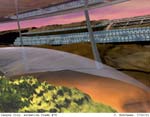Long-time Mission Manager Dreams of Humans Exploring Mars Someday
After spending a career in planetary exploration, Charley Kohlhase
dreams not of the past, but of the future. What does he envision
someday? Humans living on Mars, continuing to study the planet in
great detail. Of course, NASA has a lot of work to do before human
missions are possible, but today's robotic missions are paving the way
by helping us understand the Martian environment and its potential
impact on human health. Once we learn more, Kohlhase believes,
the spirit of exploration will make Mars an irresistible destination for
future astronauts.
"Like all pioneers, humans are curious to know what other
worlds are like," says Kohlhase. "Exploring is deeply
rooted in our very nature."
Because Kohlhase can't go to Mars himself, he uses computer
programs to create artistic, futuristic scenes of what Mars exploration
could be like far in the future. One of his most recent images is
called "Canyon City, Mars, Circa 2130." The image
depicts an otherworldly family gardening scene. A spacesuited
father and daughter, five generations from now, tend to a sheltered
cactus plant on the surface of Mars. It evokes the simple pioneering
spirit of working the land in a new world, while suggesting the fantastic
possibilities of people from Earth actually residing on another planet.
 |
|
Computer generated artwork of a family gardening on Mars in 2130. |
|
He describes the vision that led him to create the work: "In
2130, the leaders of my imagined Canyon City will hopefully be young
scientists who will conduct the first plant experiments in special
field-controlled domes. They will search for ways to leave the red
planet both Mars-like and Earth-like if at all possible. They must
have food, of course, much of which can be grown in hydroponic
greenhouses, but they will also yearn for natural fruit, perhaps
from desert-like plants that remind them of Earth."
A longtime space explorer himself, Kohlhase's childhood imagination
was enriched by adventure stories and books of science fiction and
science fact. He built model airplanes and dreamed of flying. At age
11, he taught himself Boolean algebra and used it to design a small
puzzle-solving machine. His studies of math and physics were fueled
by his wonderment at nature and visions of what might be possible in
future explorations of the universe.
As a relatively new employee at JPL in 1960, he presented the first
feasible flight path for a mission to Mars to then-director William Pickering
and rocket innovator Wernher von Braun. Kohlhase lived the dream of
flying such a mission in the mid-1960s with the Mariner 4 Mars mission,
again in the late 1960s with Mariners 6 and 7, and in the mid-1970s,
with the Viking mission to Mars.
He was the mission design manager for the Voyager 1 and
Voyager 2 project, the historic robotic spacecraft mission that
completed the so-called "Grand Tour" of Jupiter, Saturn,
Uranus and Neptune. The spacecraft, still operating, are now well
beyond the planets and on the interstellar leg of their mission, nearing
the boundary of the Sun's influence. After the Voyager mission, Kohlhase
was the science and mission design manager for the Cassini mission to
Saturn launched in 1997 and set to arrive at Saturn in 2004. Though
now "retired," he is currently a member of the Mars Program
Systems Engineering Team, helping to improve the resiliency and
future of the Mars Exploration Program.
 |
|
A frame from an animation showing your flight as it banks and barnstorms
its path through the experimental forest station. Reflections of
the human facilities can be seen in the underside of the huge
lens used to concentrate the weak sunlight at Mars on
the emerging forest. View animation
|
|
Artistically, he is a devoted and experienced photographer of forty
years, with creative digital imagery added to his repertoire within the
past decade. Kohlhase's images have appeared in numerous venues
including Sierra Magazine and other Sierra Club outlets, several one-year
installations at the Jet Propulsion Laboratory, the Pacific Design Center
Showcase Idea House, 1994 Best of Photography Annual, various public
buildings and private galleries. As in his "Canyon City" image,
much of his artwork draws upon his scientific and engineering expertise as
the basis for imaginative depictions of future explorations.
Kohlhase has frequently collaborated with educational organizations to
help inspire science and math teaching. He is a frequent speaker at
NASA conferences for educators, and often uses his artwork and the
work of others to help teachers build bridges that will lead more students
to appreciate and study science and math.